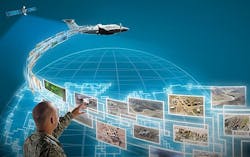ATCorp to build SWaP-optimized airborne networking router prototypes for carrier-based aircraft
Officials of the Naval Air Warfare Center Aircraft Division in Lakehurst, N.J., are asking Architecture Technology Corp. (ATCorp) in Eden Prairie, Minn., to build 10 flight-ready prototype ruggedized routers for carrier-based aircraft like the E-2 Hawkeye carrier-based radar plane, as well as for much smaller aircraft like unmanned aerial vehicles (UAVs).
Navy officials announced plans Wednesday to award ATCorp a yearlong phase-3 small business innovation research (SBIR) contract for the Minimized Space, Weight and Power Network Architecture Solution project. The value of the upcoming contract has yet to be negotiated.
Despite determined research efforts, interoperability of new IP-enabled tactical radios remains elusive, Navy researchers say. Though it's possible to create a tactical network of different IP-enabled radios, such networks are ill-suited to changes in topology and link quality typical of a Navy aircraft carrier strike group's networked air-, sea-, and land-based elements.
ATCorp engineers will build small size, weight, and power consumption (SWaP) rugged routers called small-form-factor automated networking (S-FAN) systems to provide pervasive, adaptive communications over different airborne communications links.
This S-FAN effort, which Navy researchers and ATCorp experts are carrying out for the Navy's Unmanned Carrier Aviation Program Office (PMA-268) at Patuxent River Naval Air Station, Md., seeks a dramatic improvement in router configuration that enables carrier strike groups to create, configure, and modify tactical networks quickly.
ATCorp engineers will capitalize on off-the-shelf MIL-STD-810G-compatible hardware that the company previously has flight tested, Navy officials say.
ATCorp will provide prototypes of a minimized SWaP network architecture solution, ruggedized sufficiently for carrier-based aircraft, as well as support prototype installation and flight testing.
Related: Rugged routers enable the network-centric battlefield
These prototype airborne routers will be packaged as electronic cards or boxes with minimal SWaP that are compatible with existing aircraft data links, Navy researchers say.
Advanced airborne sensors provide detailed data for detection, identification, and targeting, experts say. Still, to share sensor information among many different users in real time requires a system that aggregates data in real time or near real time over airborne networks to help create an integrated and shared warfighting picture.
Radar, signals intercepts, imagery, and other electromagnetic data can be valuable when shared among several platforms simultaneously. Data fusion and data correlation systems can help build tactical situational awareness when aggregating data from several sensors.
ATCorp is building prototype airborne networking routers that can enhance the ability of aircraft to share sensor data over networks with high throughput, low latency, and increased reliability.
The company's networking solution will be suitable for several different aircraft installations, and enable multiple aircraft or other mobile platforms to share information in a distributed environment.
In the first and second phases of this project, ATCorp engineers designed a small-form-factor multi-link networking solution for aircraft for routing, switching, optimization, security and monitoring, and tested the router in the lab.
Now, in the project's third phase, ATC experts will design an airborne networking router and test it on the Navy's E-2D carrier-based radar surveillance and battle-management aircraft, and plan for installations on other Navy and commercial aircraft.
For more information contact ATCorp online at www.atcorp.com, the Naval Air Warfare Center Aircraft Division-Lakehurst at www.navair.navy.mil, or the Navy's Unmanned Carrier Aviation Program Office at www.navair.navy.mil.
Learn more: search the Aerospace & Defense Buyer's Guide for companies, new products, press releases, and videos
